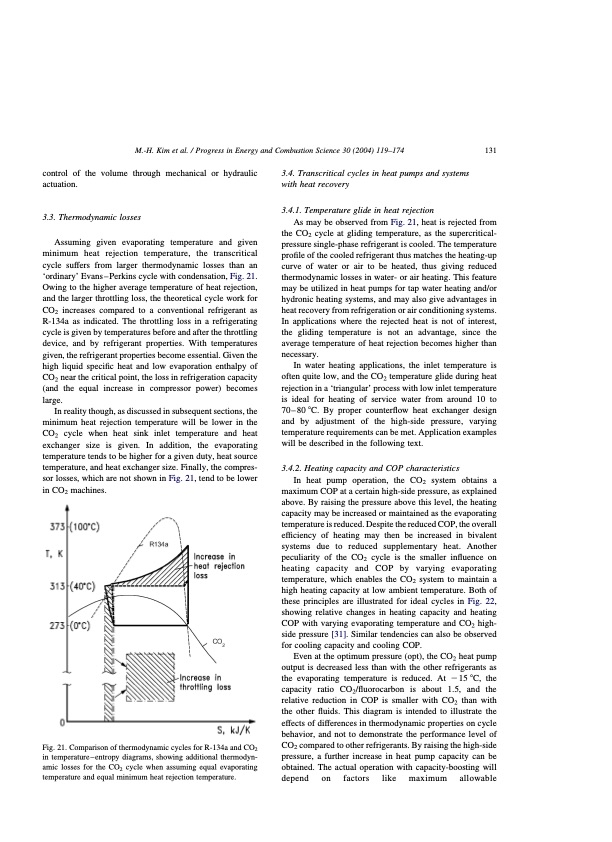
PDF Publication Title:
Text from PDF Page: 013
M.-H. Kim et al. / Progress in Energy and Combustion Science 30 (2004) 119–174 131 control of the volume through mechanical or hydraulic actuation. 3.3. Thermodynamic losses Assuming given evaporating temperature and given minimum heat rejection temperature, the transcritical cycle suffers from larger thermodynamic losses than an ‘ordinary’ Evans – Perkins cycle with condensation, Fig. 21. Owing to the higher average temperature of heat rejection, and the larger throttling loss, the theoretical cycle work for CO2 increases compared to a conventional refrigerant as R-134a as indicated. The throttling loss in a refrigerating cycle is given by temperatures before and after the throttling device, and by refrigerant properties. With temperatures given, the refrigerant properties become essential. Given the high liquid specific heat and low evaporation enthalpy of CO2 near the critical point, the loss in refrigeration capacity (and the equal increase in compressor power) becomes large. In reality though, as discussed in subsequent sections, the minimum heat rejection temperature will be lower in the CO2 cycle when heat sink inlet temperature and heat exchanger size is given. In addition, the evaporating temperature tends to be higher for a given duty, heat source temperature, and heat exchanger size. Finally, the compres- sor losses, which are not shown in Fig. 21, tend to be lower in CO2 machines. Fig. 21. Comparison of thermodynamic cycles for R-134a and CO2 in temperature–entropy diagrams, showing additional thermodyn- amic losses for the CO2 cycle when assuming equal evaporating temperature and equal minimum heat rejection temperature. 3.4. Transcritical cycles in heat pumps and systems with heat recovery 3.4.1. Temperature glide in heat rejection As may be observed from Fig. 21, heat is rejected from the CO2 cycle at gliding temperature, as the supercritical- pressure single-phase refrigerant is cooled. The temperature profile of the cooled refrigerant thus matches the heating-up curve of water or air to be heated, thus giving reduced thermodynamic losses in water- or air heating. This feature may be utilized in heat pumps for tap water heating and/or hydronic heating systems, and may also give advantages in heat recovery from refrigeration or air conditioning systems. In applications where the rejected heat is not of interest, the gliding temperature is not an advantage, since the average temperature of heat rejection becomes higher than necessary. In water heating applications, the inlet temperature is often quite low, and the CO2 temperature glide during heat rejection in a ‘triangular’ process with low inlet temperature is ideal for heating of service water from around 10 to 70–808C. By proper counterflow heat exchanger design and by adjustment of the high-side pressure, varying temperature requirements can be met. Application examples will be described in the following text. 3.4.2. Heating capacity and COP characteristics In heat pump operation, the CO2 system obtains a maximum COP at a certain high-side pressure, as explained above. By raising the pressure above this level, the heating capacity may be increased or maintained as the evaporating temperature is reduced. Despite the reduced COP, the overall efficiency of heating may then be increased in bivalent systems due to reduced supplementary heat. Another peculiarity of the CO2 cycle is the smaller influence on heating capacity and COP by varying evaporating temperature, which enables the CO2 system to maintain a high heating capacity at low ambient temperature. Both of these principles are illustrated for ideal cycles in Fig. 22, showing relative changes in heating capacity and heating COP with varying evaporating temperature and CO2 high- side pressure [31]. Similar tendencies can also be observed for cooling capacity and cooling COP. Even at the optimum pressure (opt), the CO2 heat pump output is decreased less than with the other refrigerants as the evaporating temperature is reduced. At 2158C, the capacity ratio CO2/fluorocarbon is about 1.5, and the relative reduction in COP is smaller with CO2 than with the other fluids. This diagram is intended to illustrate the effects of differences in thermodynamic properties on cycle behavior, and not to demonstrate the performance level of CO2 compared to other refrigerants. By raising the high-side pressure, a further increase in heat pump capacity can be obtained. The actual operation with capacity-boosting will depend on factors like maximum allowablePDF Image | CO2 Vapor Compression Systems

PDF Search Title:
CO2 Vapor Compression SystemsOriginal File Name Searched:
co2-vapor-compression-systems.pdfDIY PDF Search: Google It | Yahoo | Bing
CO2 Organic Rankine Cycle Experimenter Platform The supercritical CO2 phase change system is both a heat pump and organic rankine cycle which can be used for those purposes and as a supercritical extractor for advanced subcritical and supercritical extraction technology. Uses include producing nanoparticles, precious metal CO2 extraction, lithium battery recycling, and other applications... More Info
Heat Pumps CO2 ORC Heat Pump System Platform More Info
| CONTACT TEL: 608-238-6001 Email: greg@infinityturbine.com | RSS | AMP |